For more information, visit https://www.savagearms.com/firearms/model/msr15recon.
To purchase a Savage MSR rifle on GunsAmerica.com, click this link: https://www.gunsamerica.com/Search.aspx?T=Savage%20MSR.
Savage has now broken into what is currently the largest segment of the rifle market, bringing along their 123 years of rifle-making history into its MSR (modern sporting rifle) line of AR-style rifles. I was understandably eager to see how they could impact this established market in a state of change.
Savage has brought several rifle/caliber choices to market, with the MSR class. They open with the .223 Wylde Patrol priced at an MSRP of $852, intended as the “entry level” gun of the line (although it has many upgrades and features that set it apart from other ARs classed that way, and costs more accordingly). The next step up from that is the Recon at an MSRP of $999, which has even more improved features. Both guns are based on the traditional direct-gas-impingement AR platform.

The new MSR 15 Recon in .223 Wylde from Savage is priced at an MSRP of $999 and offers a lot of interesting enhancements and upgrades over a standard AR. Image courtesy of manufacturer.
The next two in the lineup are the MSR 10 Hunter in .308 or 6.5 Creedmoor at $1,481 MSRP and the MSR 10 Long Range at $2,284 and also in .308 or 6.5 Creedmoor. Both are available in either 308 Win. or 6.5 Creedmoor. As the name suggests, the Hunter is a rifle that Savage would like you to carry into the woods for game-getting. The Long Range is geared up for the target shooter and big-bore AR enthusiast. Their choice of calibers will fit well in its intended role.
SPECS
- Chambering: .223 Wylde
- Barrel: 16.125 inches
- OA Length: 33.5 – 36.75 inches
- Weight: 7 pounds
- Stock: Axiom collapsible stock
- Sights: Flip-up Blackhawk
- Action: Direct gas impingement
- Finish: Matte black
- Capacity: 30+1
- MSRP: $999
Waiting On My Box
I did some quick research while waiting on my test rifle to arrive. I discovered that the Recon is an upgrade on the MSR 15 Patrol platform. These upgrades are good looking and also great functioning. The Recon receiver is a custom forged upper/lower set-up while the MSR 15 Patrol features a traditional mil-spec upper and lower receiver. The trigger is upgraded to the AR Blaze single-stage duty trigger (see our full review of the Blaze here: https://www.gunsamerica.com/blog/trigger-technology-blackhawks-new-blaze-trigger-ar-15-rifles/) on the Recon over the standard mil-spec trigger on the Patrol. It is boron coated and does not require lubrication.

The custom forged lower receiver is a real eye catcher. Controls are standard AR. The rifle comes standard with the single-stage Blackhawk Blaze trigger.
The barrel for both the Recon and Patrol are both 16.125 inches and chambered for .223 Wylde (more on that in a moment). The barrel itself is hidden gem from Savage; it looks like a standard 16-inch barrel threaded and topped off with an A2-style muzzle brake/flash suppressor, but the secret sauce is something that is referred to as 5R rifling. 5R is an improvement over conventional rifling, achieved by changing the shape and configuration of the lands and grooves. 5R is an upgrade in two ways: the number of lands and grooves is an odd number, and the lands and grooves themselves are sloped.
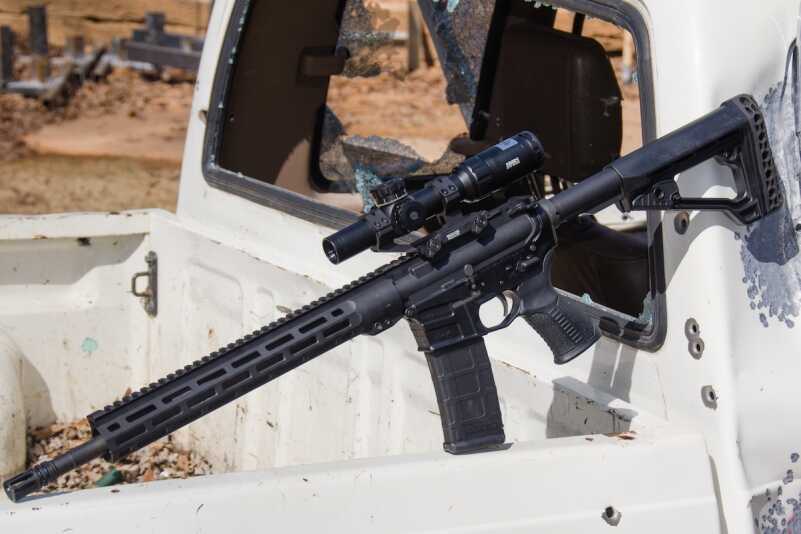
The rifle proved to be a real performer on the range for the author, running a lot of ammo and doing quite well downrange.
This configuration provides a couple of advantages. With the lands opposite of the grooves, the bullet is not squeezed on opposite sides, keeping the bullet uniform while traveling the barrel, and thus adding to its accuracy. The slope of the lands allows the barrel to be cleaned easily and more effectively, as these corners tend to store lead and copper from shooting, which can cause accuracy issues over time. The barrel has been treated with Melonite. Without getting too technical, Melonite is a treatment for metal that makes the surface harder than chrome and very slick.
Whereas the Patrol has a Blackhawk handguard and fixed front sight unit, the Recon has a free-floated Midwest Industries M-LOK handguard with a flip-up front sight. This mates up with a Blackhawk flip-up rear sight unit on the flat-topped upper receiver. The top of the handguard has a single, long strip of Picatinny rail while side and bottom rail sections can be added as needed. Whereas the Patrol does not have a forward assist button in the housing, the Recon comes standard with a fully functional forward assist unit. I personally like having one on my rifles and the Recon has it.
Unboxing
When the Recon arrived, I took it out for the usual look-over. The first thing I noticed was that the lower receiver was not of standard fare. This was not billet but a forged lower with a custom design that looked like a billet receiver. This custom piece really set off the gun with its lines.
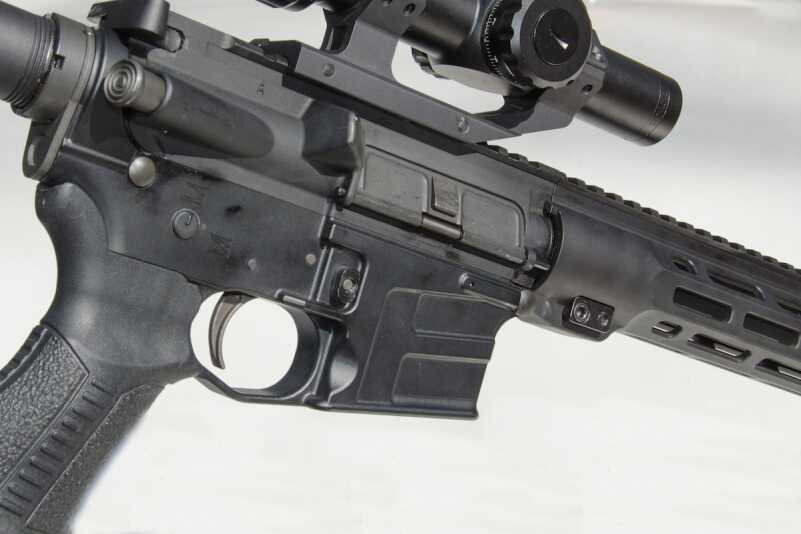
The rifle’s lower receiver has a distinctive and attractive look. Note the integral, oversized triggerguard.
The pistol grip and six-position buttstock were from Blackhawk, and both felt solid and comfortable. The Blackhawk stock was well-padded and soaked up recoil admirably. The stock has a honeycomb pad on the end that is light and comfortable to mount. The pull is adjusted by depressing a lever at the front of the stock. The pistol grip was also branded Blackhawk, and seemed a bit oversized. With an extended backstrap, it turned out to be quite comfortable.
All the controls seemed to be standard, until I tried the trigger. The Recon’s Blaze trigger was quite impressive: Short, crisp and easy to pull. My trigger pull gauge said the trigger broke consistently at 3 pounds, 15 ounces, while my calipers indicated that it traveled .11 of an inch, total. This is a great trigger, especially considering that I expected to find some special match trigger with endless set screws and chassis. I was pleased both by the trigger’s feel and its standard-looking parts, right down to the full-mass hammer.
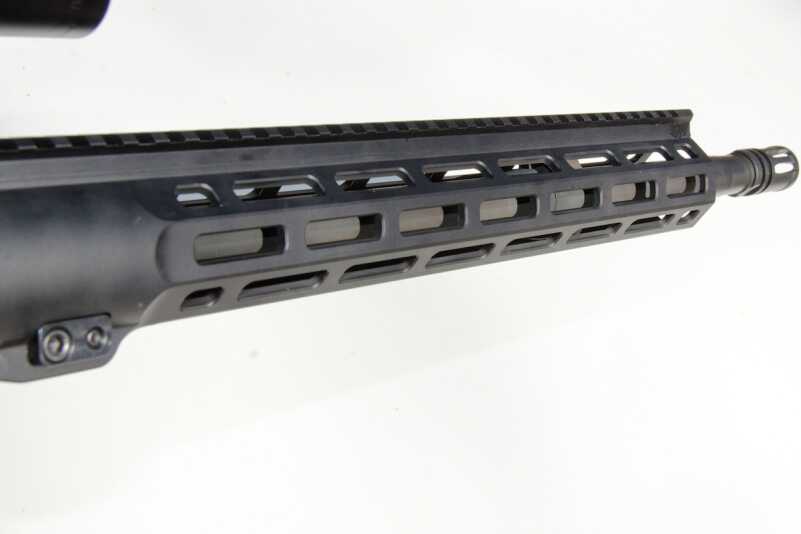
The handguard is a Midwest Industries free-floated M-LOK unit with a top strip of Picatinny rail. The barrel is Melonite coated.
The sights are Blackhawk flip-up front and rear, as noted above. The M-LOK handguard was smooth and firmly-mounted via the barrel nut mount, with locking fingers on either side of the rear of the handguard extending to either side of the upper receiver. Accessories can be mounted on the full-length rail on top of the handguard, and additional Picatinny mounts can be affixed, if you are into that sort of thing. My example did not come with any additional rail sections.
Now, to get technical … . The Melonite on the rifle is applied in a salt bath ferritic nitrocarburizing. This mixture of nitrogen, oxygen, and carbon are simultaneously forced into the steel that is being treated. They bind and produce a single layer that impregnates the steel deeper than bluing or chroming. It becomes anywhere from a Rockwell Hardness of 55 to 65. All of this and it only adds .0005-inches of thickness to treated metals.
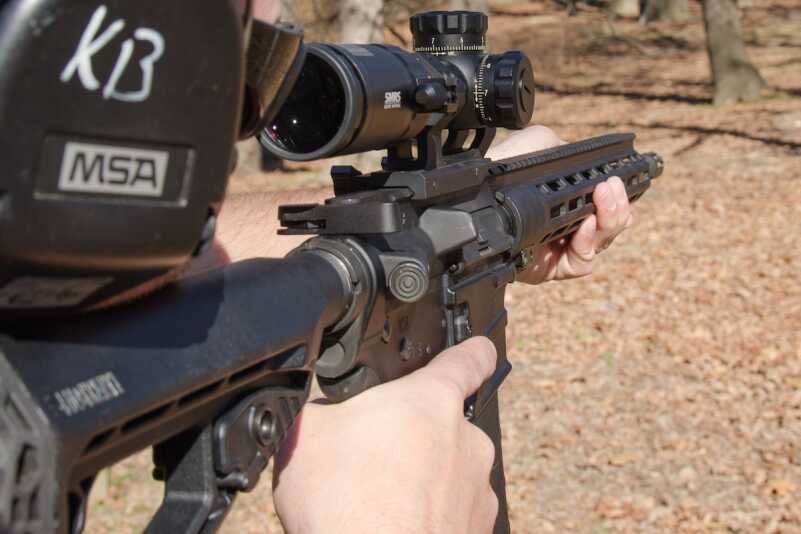
The author ran the rifle with a Bushnell Elite Tactical optic. Note the functional forward assist assembly.
The twist rate of the Recon is 1:8, meaning simply that for every eight inches of barrel length the bullet will spin one full rotation. This will generally mean the sweet spot for bullet weight will be 62 gr-77 gr. A 1:9 twist rate would work well for a lighter weight like a 55 grain. A 1:7 twist would work great in a gun you were shooting 80 gr bullets in. The twist rate will not dictate what you can shoot but rather what will shoot most accurately in your rifle.
We pause for a brief discussion of .223 Rem., 5.56 NATO & .223 Wylde. The .223 Remington and 5.56×45mm NATO chambers have slightly different dimensions, and a 5.56 can shoot a .223 Remington safely while a .223 will chamber a 5.56 round but the pressure can make it unsafe. Confused yet?
Bill Wylde of Greenup, Illinois, solved this confusion by introducing the .223 Wylde chamber. The chamber has the external dimensions and lead angle of the military 5.56×45mm NATO cartridge and the 0.2240-inch free bore diameter of the .223 Remington cartridge. This allows a barrel to safely shoot safely both the .223 and 5.56×45mm NATO ammunition while also increasing accuracy potential across the range of potential pressures.
A Great Optic
My sample rifle came with an Elite Tactical SMRS (Short Midrange Rifle 1-6.5x24mm) from Bushnell, mounted on a Weaver mount. This second focal plane scope is a great choice for any .223 rifle, with the 1-6X magnification working from close-up all the way out to the effective distance of the bullet. The folding ThrowDown PCL (power change lever) makes quick magnification changes easy. The mil-based illuminated BTR-2 reticle is fast and intuitive, and gives the shooter holdovers. The T-Lok locking target turrets allow secure, repeatable adjustments with simple and robust knobs. This is not included with the rifle out of the box, but makes a great addition.
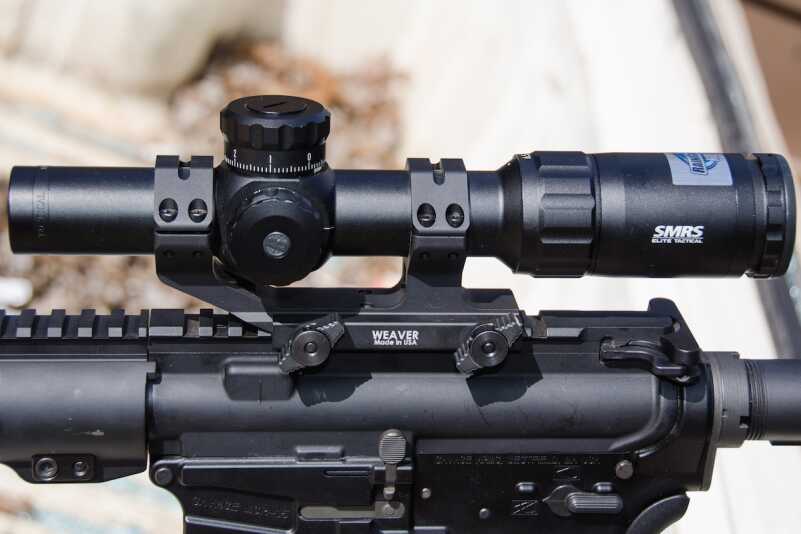
The sample rifle came with an Elite Tactical SMRS (Short Midrange Rifle 1-6.5x24mm) from Bushnell, mounted on a Weaver mount.
On the Range

The author found that the Recon shot well across the board, but really preferred heavier bullet weights.
I was in the middle of some spring training when I took the Recon to the range, and had the occasion to show the gun off to some of the local LE snipers. They all commented on the trigger and how well it performed without being some finicky custom job. The consensus was that the barrel was the real magic. I quickly found that this gun prefers heavy bullets in its diet. Its performance went from “good” to “WOW” upon transitioning from a 55 gr. to a 68 gr. round. I eventually went up to a 75 gr. bullet during my bench testing. The 55 grain did not perform badly so much as the heavier grain rounds performed spectacularly, and when shooting across 100 yards the difference was simply nice. However, reaching out past 100 yards, the weight of the round begins to make a difference in a meaningful way.
I got the rifle quite hot over the course of my testing and the point of aim would move some from a cold barrel to a hot barrel, but there were no issue beyond what one normally sees in all guns as they heat up.
I had no issues from the gun in terms of reliability. I did put some oil on the bolt as it looked a little dry, but not because of a malfunction. Applying the oil allowed me to get a good look at the bolt and identify it as an M16 bolt. I tested this by putting the Savage upper on an M16 lower I have; it delivered full auto, as expected.
 A Modern Sporting Rifle
A Modern Sporting Rifle
Without question, this rifle is built for serious purposes. Great choices were made when the plans for this rifle were laid, and those plans were executed well. In my personal opinion, there is just one problem with this rifle: Trump is POTUS, and with the 2nd Amendment appearing safe for now, the market has moved. Inventory levels are high and prices are in decline. The reality is that Savage may have a hard time competing with the Recon’s current retail price. I feel certain that adjustments will come quickly, and this will become a forgotten problem.
For more information, visit https://www.savagearms.com/firearms/model/msr15recon.
To purchase a Savage MSR rifle on GunsAmerica.com, click this link: https://www.gunsamerica.com/Search.aspx?T=Savage%20MSR.


If like most savages it will be a keeper all the Savages that I have bought over the years all could shoot 1/2 in at a 100 yards with good ammo and some did better than that had 2 bolt guns that shot 1/4 at a 100 yards
Thanks For this amazing article
This may be the most clearly written review I’ve ever read. Considering I am in the market for this firearm, it was nice to hear all the good things you had to say about it. I already knew Savage made excellent firearms, and to this day, I have not yet purchased an AR style (though I do own a Mini-14 tactical w/muzzle brake). The minute I saw the MSR 15 Recon, it said buy me. Went out an handled a patrol model yesterday and it felt better than I imagined. The only thing I personally think I will change out, is the pistol grip to an ATI Scorpion. Most likely I will be going out an picking up one of these in the next month or two. Haven’t yet locate the Recon model in stock at any local dealers, just the Patrol model. Some dealers seemed dazed when I asked about the Savage MSR 15; as if they never heard of it. Guess those sales people were not really firearm enthusiasts, but just sales people.
Anyway, nice job, thanks! Looks like I’ll save about $1000 buying this, rather than the LMT I’ve been eyeing for about 6 years and watched the price go up about $550!
Being a bolt gun guy , right out of the box , Savage shoots tighter groups than Remington . With the exception of the Savage BA 10 /338( P.O.S right back to factory wouldn’t fire / sold it after factory fix ) . But at $1k bet this shoots tighter than any out of the box Colt …
Why do you prefer forward assist?
Well done writeup, thank you! It’s refreshing to read a professional review on GA, for a change. It seems, lately, that too many reviews are casually done and exhibit poor writing skills, as well as needless foul language. Even in this time of ‘plenty’, concerning MSRs, there is a place for another quality example. I’ve always appreciated Savage barrel quality. Hopefully that quality proves true in their AR/MSR line.
POMPOUS ASS /pämpəs as/ (adjective)- A foolish person characterized by excessive self-esteem or exaggerated dignity; pretentious: pompous persons who enjoy giving critiques. Full of high-sounding phrases; bombastic: a pompous proclamation. Archaic Characterized by pomp or stately display: a pompous comment.
4 lb, 15oz pull, or 3 lb, 15oz trigger pull?
Video says former, article says latter.
The video is incorrect ,I misspoke thank you for bringing it to my attention I will update in description.
OUTSTANDING REVIEW, VIDEO and Pics Mr. Hodoway!
Can anyone provide a verified instance of a .223 rifle (of any make) exploding because a 5.56 NATO round was fired in it?
This is a serious question on my part. Is this a genuine problem or just an theoretical/imaginary fear?
The Wylde chamber has been extensively trialed through many hundreds of thousands of rounds. I personally use this chamber exclusive of all others for accuracy reasons through AR platforms. I have actually worn out barrels many times with full auto fire and no difficulties at all. Contrary I have had military guns blow bolts and gas tubes and one barrel split but NONE due to cartridge. I have not see or heard of a single instance of failure due to the Wylde chambering. IMHO the chamber is safer than the standard .223 if you try running mil 5.56 also. By today’s standards the metallurgy in barrels give a substantial pressure safety margin if properly manufactured. Make sure you barrel is made by a trustworthy manufacturer.
I personally blew a .556 M193 case in a .223-chambered AR back in about 1993. It was an interesting experience. I was/am really glad I was wearing eye protection at the time. The case blew longitudinally from just forward of the web to the case-mouth. The rifle was undamaged, but I caught some brass fragments in the face.
.223 chamber IS 5.56 with slight less lead .. and NO known probs I have seen or even heard of in 30 years.
Please consult your chamber comparisons. The 5.56 does give slightly higher pressures within SAAMI specifications.
Where did you get the idea it would “explode”??
No one mentioned detonation, did they?
In short, there have been instances of some .233 rifles being damaged by 5.56 in the chamber, one of them being the Ruger Mini 14.
In these cases, most are damaged bolts, being battered by excessive pressures.
I have personally seen this on a Ranch Rifle I sold to a friend.
I warned him, he instead listened to some yahoo of another friend.
They were shooting Green tips (M885) and being crazy.
And he had a tendency to really shoot fast, several mags at a time, and really heat that gun up.
The bolt slamming the back fractured the receiver, and it showed excessive wear on the bolt lugs.
ALL mini 14’s except for the target model are chambered for .223 and 5.56
Explode, no. Blowing the primers into the receiver and gumming up the works, yes. Could be the chamber wasn’t properly bored, but it worked fine with regular .223, not so much with 5.56. Past history, the rifle is long gone.
I searched google images for AR15 kaboom and AR blowup then went to site listed. Most are 300BO related and the rest others were speculation on cause. There is often stupidity, or liability involved with a good amount of handloading or prior possible squib mentioned. SAAMI Specs the .223, they do not Spec the 5.56. The No-No warnings are based on safety margins and they are impacted by individual chambers, cases, powder and primer. We can chrono and read deviations within the same lot of ammo: vel is the result of pressure. All of these could combine to a adverse condition from minor primer melt or blowout, FTEX or Kaboom. I believe the real adverse problems with 5.56 in a .223 came about over issues with the Ruger Mini 14. I have personally seen two State Agency Ruger GB14’s jump bolts off charging handle and lock up. Disassembly showed no visible damage but Ruger replaced both of them. AMMO was Factory fresh Rem .223 not the higher pressure 5.56.
The long “Roll the dice, take your chances” answer:
http://www.luckygunner.com/labs/5-56-vs-223/
I agree….well laid plans and well executed. Sounds like this walks all over the Springfield’s “Saint”….which I thought was a disappointment. I am personally all about the mid-heavier bullets in the 223/5.56. A great looking rifle that doesn’t need a bunch of crap done to make it a great shooter. Bravo, Savage!!! Great review! Thanks!!
I run on the basis that if my ol 100 plus year old 6.5 swede Mauser shoots under MOA I figure we should be at half that a Century later.
For sure or we just ain’t that techo smart now are we??
grammar intentional.
Love those Swede’s!
they are sweet ,been eyeing one for years ,with the latest ban craze’s been hard to buy one
Well ok, but a comparison of ANY rifles actual ‘accuracy’ is only really valid if done by bench standards.
And in all cases, the ammo plays a huge part.
Too many variables to begin with, not to mention that quite frankly most rifles shoot far better than the people shooting them ,and have been for over a century.
The tech has been there that long.